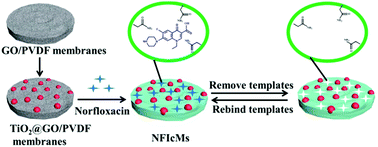Molecularly imprinted nanocomposite membranes based on GO/PVDF blended membranes with an organic–inorganic structure for selective separation of norfloxacin†
Abstract
Antibiotic pollutants in water have received remarkable attention due to the untold damage to human health and the environment, yet no approach has been used to solve the problem effectively. In this work, novel and efficient norfloxacin-molecularly imprinted composite membranes with an organic–inorganic structure (NFIcMs) were designed and developed using GO/PVDF blended membranes as substrates for selective separation and fast enrichment of norfloxacin from aqueous solution. The selectivity coefficient (α) of NFIcMs was up to 7.35 and more than 1.0, and the permeability factor β values were about 6.0 and more than 1.0, which indicated that the as-prepared NFIcMs possessed outstanding selectivity and permeability. Moreover, the synergistic effects of the specific surface area of GO, fouling resistance of TiO2 and high mechanical strength of PVDF membranes resulted in the fact that NFIcMs had a high adsorption capacity (44.81 mg g−1) for norfloxacin. Additionally, the facile and eco-friendly preparation of the demonstrated NFIcMs rendered them with the application potential in the treatment of antibiotic pollutants.



 Please wait while we load your content...
Please wait while we load your content...